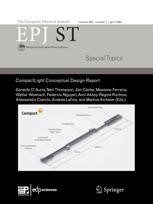Observing Flows at a Liquid-Liquid-Solid Intersection
Experiments reveal how a liquid-liquid interface interacts with a moving contact line.
New York | Heidelberg, 21 June 2024
 Most of us are familiar with the classic example of a liquid-gas moving contact line on a solid surface: a raindrop, sheared by the wind, creeps along a glass windscreen. The contact line’s movements depend on the interplay between viscous and surface tension forces - a relationship that has been thoroughly investigated in experimental fluid mechanics. In a study published in EPJ Special Topics (EPJ ST), Harish Dixit, of the Indian Institute of Technology Hyderabad, and his colleagues now examine the movements of a contact line formed at the interface between two immiscible liquids and a solid. The experiments fill a gap in fluid dynamics and suggest a mechanism for an imposed boundary condition that eludes mathematical description.
Most of us are familiar with the classic example of a liquid-gas moving contact line on a solid surface: a raindrop, sheared by the wind, creeps along a glass windscreen. The contact line’s movements depend on the interplay between viscous and surface tension forces - a relationship that has been thoroughly investigated in experimental fluid mechanics. In a study published in EPJ Special Topics (EPJ ST), Harish Dixit, of the Indian Institute of Technology Hyderabad, and his colleagues now examine the movements of a contact line formed at the interface between two immiscible liquids and a solid. The experiments fill a gap in fluid dynamics and suggest a mechanism for an imposed boundary condition that eludes mathematical description.
According to theory valid in the viscous limit, the movement of a liquid-liquid contact line should be governed entirely by the liquids’ viscosity ratio and the angle at which the liquid interface meets the solid. To examine this in a real-world system, Dixit and his colleagues filled a rectangular tank with two liquid layers—silicone oil atop sugar water - with similar densities but significantly different viscosities. The researchers placed a glass slide at the edge of the tank, which they could slide vertically to create a moving contact line.
Using a technique that tracks tiny particles introduced to the liquids and illuminated with laser light, the researchers simultaneously mapped the flow field on both sides of the liquid-liquid interface while they moved the glass slide. They found that the flow velocities rapidly decreased close to the contact line. Additionally, the liquid interface appeared to slip along the moving glass slide, rather than staying pinned to it - resolving the apparent “singularity” in models that impose a no-slip boundary condition on the moving wall.
The findings lend support to theoretical models of contact line dynamics, and offer parameters that could improve numerical simulations which are based on similar-viscosity liquids.
Reference: Gupta, C., Chandrala, L.D. & Dixit, H.N. An experimental investigation of flow fields near a liquid–liquid moving contact line. Eur. Phys. J. Spec. Top. (2024). https://doi.org/10.1140/epjs/s11734-024-01170-x
Further Information
For more information visit: www.epj.org
Services for Journalists
The full-text of the article is available here.
Contact
Sabine Lehr | Springer | Physics Editorial Department
tel +49-6221-487-8336 | sabine.lehr@springer.com
